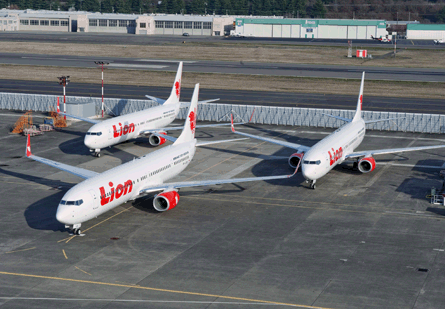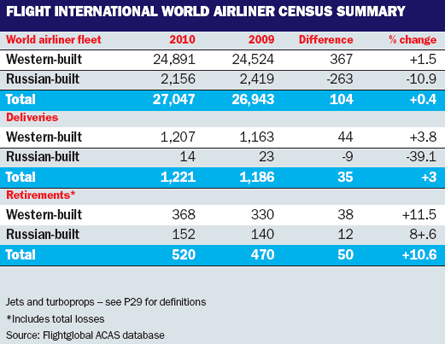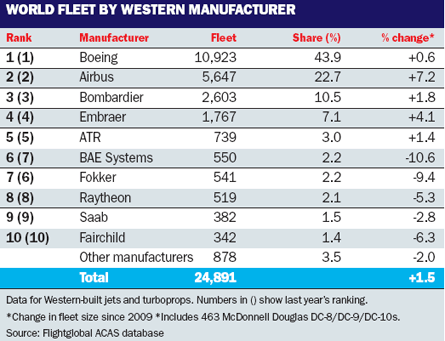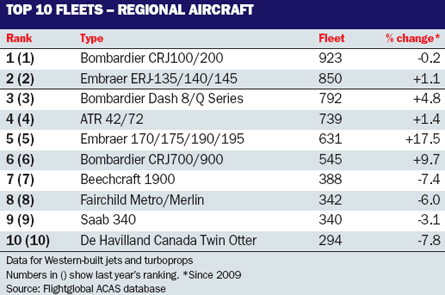The size of the world’s airliner fleet has barely changed over the past 12 months, with the minimal growth in the number of Western airliners almost entirely offset by further declines in Russian-built aircraft. Meanwhile, the idle jet fleet is at an all-time high as operators continue to park their older, less-efficient airliners.
Our annual airliner census, compiled from Flightglobal’s ACAS database, comprises 27,047 aircraft - up less than 0.5% on the 26,943 units a year ago. This growth is half that of 2008-09, when the fleet expanded by 1.1%.
The number of Western-built airliners increased by just 1.5% to 24,891 units, while decline continued for the fleet of Russian aircraft, falling to 2,156 units. The percentage drop this year reached double digits - 10.9%.
 |
|---|
© BoeingDeliveries of new airliners, like these Lion Airlines 737-900ERs, have risen but so have retirements |
The effect of the dramatic downturn in 2008-09 - which had been preceded by sky-high oil prices - has clearly had an effect on the world’s airliner fleet. Some airliners have been returned off lease to their owners (meaning that they are excluded from the Flight International census as they are no longer with a commercial operator), while others have been permanently retired. Meanwhile, the Russian-built fleet - which is ageing far faster than the West’s as the bulk were delivered between the 1960s and 1980s and there are few new aircraft deliveries - is declining as the older types are retired. Many of these are being replaced by Western equipment - much to the annoyance of the Russian prime minister Vladimir Putin who recently instructed Aeroflot to consider the country’s all-new MS-21 twinjet for its future requirements.
Total deliveries over the 12 months since the last census have risen 3% to 1,221 aircraft. But the downturn, which has resulted in a glut of parked aircraft and a downward impact on values, is reflected in the fact that the number of permanent retirements has risen by more than 10% this year, to 520 aircraft (more than two-thirds of which were Western aircraft).
 |
|---|
The number of idle Western-built jets has broken through 3,000 units, rising 7% since last year to 3,116 aircraft. This equates to over 13.9% of the entire fleet (22,471 aircraft), which is the highest proportion on record (it was 13.4% a year ago). The ongoing glut of parked aircraft, combined with the high delivery rate, has resulted in the first examples of the current generation single-aisles being broken up.
Geographically, North/South America remains the dominant region with 10,661 aircraft and a 39.4% share, followed by Europe with 8,220 aircraft and a 30.4% share. However both regions have seen slight overall declines in their fleet totals, meaning that their shares have each fallen by around half a percentage point this year.
BIG WINNER
The big winner is Asia, Australasia and the Middle East, which has seen its fleet rise by 360 units to 6,605 aircraft, boosting its share from 23.2% last year to 24.4% in 2010.
Unsurprisingly, this region’s high growth means it heads the order rankings, with its 3,049 backlog representing more than 45% of the total. But its share has declined slightly since last year. Airlines in Europe and North/South America each hold just over one-fifth of the backlog.
 |
|---|
In the individual fleet rankings, the Airbus A320 family stays top, topping 4,000 units, increasing to 4,092 aircraft, a rise of almost 10%.
The Boeing 737 Next Generation has seen huge growth, expanding by over 13% to take it beyond the 3,000-mark to 3,119 aircraft. Combined, the three generations of this ubiquitous twinjet account for just over 5,000 aircraft. This fleet total continues to rise despite that fact that increasing numbers of the older variants are leaving the census. This is highlighted by the fact that the 737-200 fleet fell almost 14% this year, causing it to drop out of the top 10.
In the widebody sector, the 777 and A330 saw double-digit percentage increases in fleet size. The Boeing big twin moved up one place to seventh - at the expense of the MD-80, which dropped two slots - and the 777 is likely to overtake at least one or maybe two types above it over the next 12 months.
The regional airliner ranking - for which the Bombardier CRJ100/200 remains at the head - has been static with no place changes. However, the Embraer E-Jet family and the CRJ700/900 again recorded healthy increases in fleet size, growing by 17.5% and 9.7%, respectively.
 |
|---|
The status of Russian types ranking is one of decline, with every type seeing a contraction in fleet size over the past year. The rankings are little changed, with the Yakovlev Yak-40 top, although the An-72/74 makes an entry at No 10, displacing the Iluyshin Il-62.
The Airbus/Boeing order backlog (airlines and undisclosed operators only) is down slightly on last year, but the market splits are similar. The home markets go the predictable way, with Airbus ahead in Europe (albeit marginally), while Boeing has a more convincing lead over its rival in North/South America. In Asia, Australasia and Middle East Airbus has a healthy advantage, with a 55% market share.
Boeing continues to have the lion’s share (albeit a declining one) of the 24,891 Western-built airliners in the census - in fact its fleet size increased slightly to 10,923 aircraft. The Airbus fleet saw another 7%-plus increase, which sees it retain its roughly one-fifth share. Its 5,647 fleet tally is more than double that of the next placed airframer, Bombardier, which has 2,603 airliners in the census.
 |
|---|
The Embraer airliner fleet has increased by 4%, but it is still significantly below that of regional opponent Bombardier. However, as forecast in these pages a year ago, the Brazilian airframer can now boast a bigger overall regional jet fleet than its Canadian rival, with 1,481 ERJs and E-Jets in the census, compared with 1,468 CRJs.
Source: Flight International



















